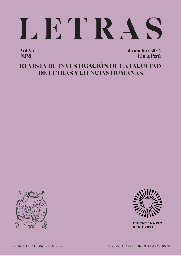Antígona González: The Constant Construction of Memory
Abstract
Antígona González is a theatrical work or a dramatic poem made up of a collection of texts. The book functions as a collective memory that is constantly created and re-created. The freedom in which the theatrical scenes are altered (in modern dance and theatre) can be interpreted as if they were memories in perpetual construction. The work is written as a pastiche —an accumulation of texts— that include testimonies of a diverse population affected by violence, as well as news stories and online blog posts. Each of these items add their own snippets to this innovative theatrical work that continues to compose itself and recompose itself as if it were a living collage. Antígona González is a unique work because of the way in which it constructs a collective memory through the constant updates and remediations which, in turn, incorporate the voices of those who have been silenced. In turn, it demands the action of the reader or the spectator. Its objective is to empower and embolden the viewer to rise up and make it such that the killings and the disappearances of Mexicans are never forgotten.Downloads
Métricas alternativas
References
Aguilera López, J. y Castañeada Barreda, E. (2018). La poesía mexicana del siglo XXI ante la crisis institucional: apuntes para un panorama estético. América Sin Nombre, 23, 85-96. https://doi.org/10.14198/AMESN.2018.23.06.
Alicino, L. (2020). El cuerpo colectivo de Antígona. Mito y reescrituras en Antígona González de Sara Uribe.
Rassegna Iberistica, 43(114), 321-339. http://doi.org/10.30687/Ri/2037-6588/2020/114/005
Benjamin, W. (2016). Selected Writings. Belknap Press of Harvard University.
Bolte, R. (2017). Voces en off: sobre el desplazamiento del decir poético frente a la violencia. Manca de Juana Adcok y Antígona González de Sara Uribe. Tintas. Quaderni di letterature iberiche e iberoamericane, 7, 59-79. https://doi.org/10.13130/2240-5437/9373
Bolter, D. y Grusin, R. (1999). Remediation: Understanding New Media. Cambridge: MIT Press.
Cabrera García, E. y Alirangues López, M. (2019). Duelo y memoria de los cuerpos ausentes en Antígona González. Impossibilia, 18, 36-65. https://doi.org/10.32112/2174.2464.2019.324
Cantarello, M. (2020). Writing about Crime in Absentia: The Case of Sara Uribe’s Antígona González. Confluenze: Rivista Di Sttudi Iberoamericani, 12(1), 161-182. https://doi.org/10.6092/issn.2036-0967/11337
Cruz Arzabal, R. (2015). Escritura después de los crímenes: dispositivo, desapropiación y archivo en Antígona
González de Sara Uribe. En Quijano, M. y Vizcarrra, H. F. (Eds.), Crimen y ficción. Narrativa literaria y audiovisual sobre la violencia en América Latina (pp. 315-336). Bonilla Artigas Editores, Universidad Nacional Autónoma de México.
Erll, A. & Rigney, A. (2009). Introduction: Cultural Memory and its Dynamics. In A. Erll & A. Rigney (Ed.), Mediation, Remediation, and the Dynamics of Cultural Memory (pp. 1-14). De Gruyter. https://doi.org/10.1515/9783110217384.0.1
Erll, A. (2010). Cultural Memory Studies: An Introduction. En A. Erll & A. Nünning (Ed.), Cultural Memory Studies: An International and Interdisciplinary Handbook (pp. 1-18). De Gruyter. https://doi.org/10.1515/9783110207262.0.1
Guillermoprieto, A. (2011). 72 migrantes. Editorial Almadia.
Halbwachs, M. (1992 [1950]). On Collective Memory (Trad. Lewis A. Coser). University of Chicago Press.
Hardt, M. & Weeks, K. (Eds.). (2000). Third-world Literature in the Era of Multinational Capitalism. En The Jameson Reader (pp. 325-340). Wiley, Blackwell. https://doi.org/10.2307/466493
Iñíguez, E. (2017). Poesía, muerte y tejido social: Necroescrituras en Álbum Iscariote de Julián Herbert. Mitologías Hoy. Revista de pensamiento crítico y estudios literarios latinoamericanos, 15, 21-34. https://doi.org/10.5565/rev/mitologias.443.
Jameson, F. (2000). The Jameson Reader (Edición de Hardt, M. y Weeks, K.). Wiley, Blackwell.
Nigro F., K. (2017). Antigone on the Border. En Ter Horst, E., Friedman, E. H. y Zaidi, A. S. (Eds.), Studies in Honor of Robert Ter Horst (pp. 65-81). University of Rochester Press.
Nora, P. (1989). Between Memory and History. Les Lieux de Mémoire. Representations, 26, 7-24. https://doi.org/10.2307/2928520.
Rivera Garza, C. (2013). Los muertos indóciles. Necroescrituras y desapropiación. Tusquets.
Rulfo, J. (2005). Pedro Páramo (Edición de José Carlos González Boixo). Cátedra.
Seydel, U. (2019). Resistir contra el olvido. La reivindicación de los desaparecidos por medio del lenguaje en Antígona González. En C. Strosetzki (Ed.), Aspectos actuales del hispanismo mundial: Literatura — Cultura — Lengua (pp. 242-254). De Gruyter. https://doi.org/10.1515/9783110450828-075
Sófocles. (2016). Antígona. Madrid: Plaza Editorial.
Steiner, G. (2000). Antígonas: la travesía de un mito universal por la historia de Occidente. Editorial Gedisa.
Straus, N. P. (2018). What is or was Postmodern Fiction?: Murakami after Borges.Mosaic: an interdisciplinary critical journal, 51(1), 87-102. https://www.muse.jhu.edu/article/688065
Uribe, S. (2012). Antígona González. Oaxaca: Sur + ediciones.
Uribe, S. (2017). ¿Cómo escribir poesía en un país en guerra? Tintas. Quaderni di Letteature Iberiche e Iberoamericane, 7, 45-58. https://doi.org/10.13130/2240-5437/9372
Williams, T. (2017). Wounded Nation, Voided State: Sara Uribe’s Antígona González. Romance Notes, 57(1), 3-14. https://doi.org/10.1353/rmc.2017.0000
Zamudio, L. (2014). El amor vivificante de Antígona González de Sara Uribe. Romance Notes, 54(1), 34-45. https://doi.org/10.1353/rmc.2014.0045
Copyright (c) 2022 Letras (Lima)

This work is licensed under a Creative Commons Attribution 4.0 International License.
Este obra está bajo una licencia de Creative Commons Reconocimiento 4.0 Internacional



















